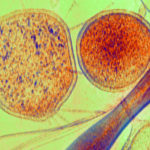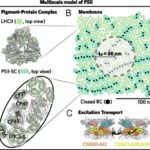By mining JGI’s massive database of microbial genomes and metagenomes, a team led by researchers at UC Berkeley and Berkeley Lab has identified a new family of CRISPR-associated (Cas) enzymes found in an ancient branch of the microbial tree of life. Just one-third the size of the seminal Cas9 protein – the business end of the gene-editing tool CRISPR-Cas9 – the new enzymes, dubbed Cas14, are the smallest functional CRISPR system discovered to date. Owing to its compact size and single-stranded DNA cutting activity, Cas14 may improve rapid CRISPR-based diagnostic systems now under development for infectious diseases, genetic mutations, and cancer.
Plant Protection Plan: When Too Much of a Good Thing is Bad
When plants absorb more light energy than they can use—such as during a brief period of intense illumination—they have mechanisms to dissipate the excess energy as heat, thereby avoiding damage to their light-harvesting pigment complexes. Research has suggested that engineering plants’ photoprotection capabilities to minimize productivity loss could increase crop yields by up to 30 percent. And that would go a long way toward meeting future global food demand. However, significant gaps remain in scientists’ understanding of the molecular details underlying these mechanisms, including how they are triggered and their activation dynamics. Now, work by Berkeley Lab scientists, reported in pair of recent papers, provides several key insights into the mechanisms underlying one type of photoprotection.
Jennifer Doudna Honored by American Cancer Society
The American Cancer Society bestowed its highest accolade, the Medal of Honor, on Jennifer Doudna, a faculty scientist in Molecular Biophysics and Integrated Bioimaging (MBIB), and four others during an October 18 ceremony in Washington, D.C. The medal is awarded to distinguished individuals who have made valuable contributions in the fight against cancer through basic research, clinical research, or public health interventions.
Doudna, a Howard Hughes Medical Institute (HHMI) investigator and professor of molecular and cell biology and of chemistry at UC Berkeley, and Emmanuelle Charpentier of the Max Planck Institute for Infection Biology in Berlin were honored for their invention of the gene-editing tool CRISPR-Cas9, which has transformed basic cancer research and spawned new cancer therapies currently undergoing trials.
Read more from UC Berkeley News.
Kuriyan Elected to National Academy of Medicine
Molecular Biophysics & Integrated Bioimaging senior faculty scientist John Kuriyan has been elected to the National Academy of Medicine, which recognizes researchers who have made major contributions to the advancement of medical sciences, health care, and public health.
Kuriyan, who is also a professor of molecular and cell biology at UC Berkeley and an HHMI Investigator, has been recognized for his work in understanding eukaryotic cell signaling regulation. Read more at Berkeley News.
Ke Xu Receives NIH New Innovator Award
Ke Xu, a faculty scientist in Molecular Biophysics and Integrated Bioimaging, has been awarded a NIH Director’s New Innovator Award as part of the National Institutes of Health’s High-Risk, High-Reward Research program. Supported by the NIH Common Fund, these grants catalyze “exceptionally innovative” biomedical research with “transformative potential” from early career investigators who have never received an NIH grant before. An assistant professor of chemistry at UC Berkeley, Xu develops new physical and chemical tools to explore biological, chemical, and materials systems at the nanoscale with extraordinary resolution and sensitivity. He takes a multidimensional approach that integrates advanced microscopy, spectroscopy, cell biology, and nanotechnology. Xu is among 89 New Innovator Award recipients for 2018. Each grant comes with $1.5 million in direct funds for five years.
Read more from UC Berkeley News.
- « Previous Page
- 1
- …
- 38
- 39
- 40
- 41
- 42
- …
- 78
- Next Page »
Was this page useful?








